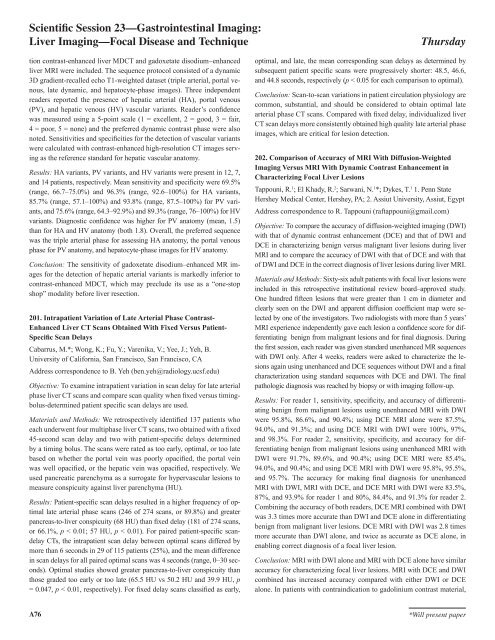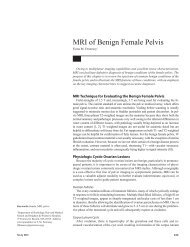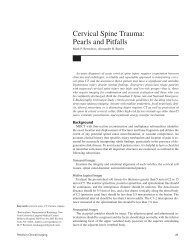Scientific Session 1 â Breast Imaging: Mammography
Scientific Session 1 â Breast Imaging: Mammography
Scientific Session 1 â Breast Imaging: Mammography
Create successful ePaper yourself
Turn your PDF publications into a flip-book with our unique Google optimized e-Paper software.
<strong>Scientific</strong> <strong>Session</strong> 23—Gastrointestinal <strong>Imaging</strong>:Liver <strong>Imaging</strong>—Focal Disease and TechniqueThursdaytion contrast-enhanced liver MDCT and gadoxetate disodium-enhancedliver MRI were included. The sequence protocol consisted of a dynamic3D gradient-recalled echo T1-weighted dataset (triple arterial, portal venous,late dynamic, and hepatocyte-phase images). Three independentreaders reported the presence of hepatic arterial (HA), portal venous(PV), and hepatic venous (HV) vascular variants. Reader’s confidencewas measured using a 5-point scale (1 = excellent, 2 = good, 3 = fair,4 = poor, 5 = none) and the preferred dynamic contrast phase were alsonoted. Sensitivities and specificities for the detection of vascular variantswere calculated with contrast-enhanced high-resolution CT images servingas the reference standard for hepatic vascular anatomy.Results: HA variants, PV variants, and HV variants were present in 12, 7,and 14 patients, respectively. Mean sensitivity and specificity were 69.5%(range, 66.7–75.0%) and 96.3% (range, 92.6–100%) for HA variants,85.7% (range, 57.1–100%) and 93.8% (range, 87.5–100%) for PV variants,and 75.6% (range, 64.3–92.9%) and 89.3% (range, 76–100%) for HVvariants. Diagnostic confidence was higher for PV anatomy (mean, 1.5)than for HA and HV anatomy (both 1.8). Overall, the preferred sequencewas the triple arterial phase for assessing HA anatomy, the portal venousphase for PV anatomy, and hepatocyte-phase images for HV anatomy.Conclusion: The sensitivity of gadoxetate disodium–enhanced MR imagesfor the detection of hepatic arterial variants is markedly inferior tocontrast-enhanced MDCT, which may preclude its use as a “one-stopshop” modality before liver resection.201. Intrapatient Variation of Late Arterial Phase Contrast-Enhanced Liver CT Scans Obtained With Fixed Versus Patient-Specific Scan DelaysCabarrus, M.*; Wong, K.; Fu, Y.; Varenika, V.; Yee, J.; Yeh, B.University of California, San Francisco, San Francisco, CAAddress correspondence to B. Yeh (ben.yeh@radiology.ucsf.edu)Objective: To examine intrapatient variation in scan delay for late arterialphase liver CT scans and compare scan quality when fixed versus timingbolus-determinedpatient specific scan delays are used.Materials and Methods: We retrospectively identified 137 patients whoeach underwent four multiphase liver CT scans, two obtained with a fixed45-second scan delay and two with patient-specific delays determinedby a timing bolus. The scans were rated as too early, optimal, or too latebased on whether the portal vein was poorly opacified, the portal veinwas well opacified, or the hepatic vein was opacified, respectively. Weused pancreatic parenchyma as a surrogate for hypervascular lesions tomeasure conspicuity against liver parenchyma (HU).Results: Patient-specific scan delays resulted in a higher frequency of optimallate arterial phase scans (246 of 274 scans, or 89.8%) and greaterpancreas-to-liver conspicuity (68 HU) than fixed delay (181 of 274 scans,or 66.1%, p < 0.01; 57 HU, p < 0.01). For paired patient-specific scandelayCTs, the intrapatient scan delay between optimal scans differed bymore than 6 seconds in 29 of 115 patients (25%), and the mean differencein scan delays for all paired optimal scans was 4 seconds (range, 0–30 seconds).Optimal studies showed greater pancreas-to-liver conspicuity thanthose graded too early or too late (65.5 HU vs 50.2 HU and 39.9 HU, p= 0.047, p < 0.01, respectively). For fixed delay scans classified as early,optimal, and late, the mean corresponding scan delays as determined bysubsequent patient specific scans were progressively shorter: 48.5, 46.6,and 44.8 seconds, respectively (p < 0.05 for each comparison to optimal).Conclusion: Scan-to-scan variations in patient circulation physiology arecommon, substantial, and should be considered to obtain optimal latearterial phase CT scans. Compared with fixed delay, individualized liverCT scan delays more consistently obtained high quality late arterial phaseimages, which are critical for lesion detection.202. Comparison of Accuracy of MRI With Diffusion-Weighted<strong>Imaging</strong> Versus MRI With Dynamic Contrast Enhancement inCharacterizing Focal Liver LesionsTappouni, R. 1 ; El Khady, R. 2 ; Sarwani, N. 1 *; Dykes, T. 1 1. Penn StateHershey Medical Center, Hershey, PA; 2. Assiut University, Assiut, EgyptAddress correspondence to R. Tappouni (raftappouni@gmail.com)Objective: To compare the accuracy of diffusion-weighted imaging (DWI)with that of dynamic contrast enhancement (DCE) and that of DWI andDCE in characterizing benign versus malignant liver lesions during liverMRI and to compare the accuracy of DWI with that of DCE and with thatof DWI and DCE in the correct diagnosis of liver lesions during liver MRI.Materials and Methods: Sixty-six adult patients with focal liver lesions wereincluded in this retrospective institutional review board–approved study.One hundred fifteen lesions that were greater than 1 cm in diameter andclearly seen on the DWI and apparent diffusion coefficient map were selectedby one of the investigators. Two radiologists with more than 5 years’MRI experience independently gave each lesion a confidence score for differentiatingbenign from malignant lesions and for final diagnosis. Duringthe first session, each reader was given standard unenhanced MR sequenceswith DWI only. After 4 weeks, readers were asked to characterize the lesionsagain using unenhanced and DCE sequences without DWI and a finalcharacterization using standard sequences with DCE and DWI. The finalpathologic diagnosis was reached by biopsy or with imaging follow-up.Results: For reader 1, sensitivity, specificity, and accuracy of differentiatingbenign from malignant lesions using unenhanced MRI with DWIwere 95.8%, 86.6%, and 90.4%; using DCE MRI alone were 87.5%,94.0%, and 91.3%; and using DCE MRI with DWI were 100%, 97%,and 98.3%. For reader 2, sensitivity, specificity, and accuracy for differentiatingbenign from malignant lesions using unenhanced MRI withDWI were 91.7%, 89.6%, and 90.4%; using DCE MRI were 85.4%,94.0%, and 90.4%; and using DCE MRI with DWI were 95.8%, 95.5%,and 95.7%. The accuracy for making final diagnosis for unenhancedMRI with DWI, MRI with DCE, and DCE MRI with DWI were 83.5%,87%, and 93.9% for reader 1 and 80%, 84.4%, and 91.3% for reader 2.Combining the accuracy of both readers, DCE MRI combined with DWIwas 3.3 times more accurate than DWI and DCE alone in differentiatingbenign from malignant liver lesions. DCE MRI with DWI was 2.8 timesmore accurate than DWI alone, and twice as accurate as DCE alone, inenabling correct diagnosis of a focal liver lesion.Conclusion: MRI with DWI alone and MRI with DCE alone have similaraccuracy for characterizing focal liver lesions. MRI with DCE and DWIcombined has increased accuracy compared with either DWI or DCEalone. In patients with contraindication to gadolinium contrast material,A76*Will present paper
















